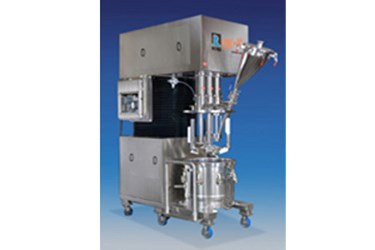Vacuum Homogenizers & Systems for Pharmaceutical Processing

Equipment strategies for increasing process versatility in the Medical Industry
The best strategy for improving the versatility and efficiency of your mixing equipment will depend upon the parameters of your particular application. But for most applications, these general guidelines will at least provide a springboard to re-examine your equipment and develop a plan to improve production.
Vacuum minimizes the time dedicated to solids transfer and wetting out
Vacuum is widely recognized for its ability to accelerate deaeration and intensify the mixing process. You can also use vacuum to transfer additions, and especially low-density powders. This will hasten the process and prevent dust from escaping into the plant atmosphere - improving operator safety and often reducing the risk of explosion. Applied correctly, vacuum readily collapses (or “densifies”) powder agglomerates floating persistently on the surface of the batch and helps to wet them out quickly.
Accelerate emulsification and dispersion by injecting additions directly into the high shear zone
Additions delivered to the surface of the batch must vortex into the batch and be carried into the high shear zone by the flow of the bulk material. This process is slow and expensive. Numerous batch turnovers are often required before agglomerates are broken down and a uniform distribution is achieved. Sub-surface injection can speed up both the mixing process and subsequent clean-up. But careful control of the vacuum injection process is crucial to avoid creating excessively violent turbulence within the mix vessel - and a long cleaning cycle later.
Sub-surface injection also helps to control heat
Heat is the inescapable by-product of the shearing action necessary to produce emulsions and dispersions. In fact, it is often the critical factor that limits the shear that can be applied to a mix – and the speed with which the mix cycle can be completed. Pharmaceutical/cosmetic mix vessels are usually jacketed to control the temperature of the batch. But the first step in controlling heat should be to minimize heat input – rather than concentrate mainly on removing heat after it accumulates. By shortening the mixing process, and reducing the total energy imparted to the batch, sub-surface injection helps to reduce heat input and avoid thermal degradation.
Choose a combination of agitators that offers a variety of mixing action
Multi-agitator mixers, such as the anchor/rotor-stator/disperser combination offer valuable flexibility. Since they are independently driven, the agitators can work together in an endless variety of combinations. Each agitator can also operate alone at a variety of speeds.
This flexibility allows the multi-agitator mixer to adjust to changing mixing requirements during a single mix cycle. Many products undergo a series of significant changes as reactions occur and the physical properties of the material evolve. With independent, variable-speed drives, the multi-agitator mixer can adapt as the cycle progresses - providing the optimal combination of shear and flow at each stage.
Choose agitator designs to ensure homogeneity – and thorough distribution of heat
The centerpiece of a high-performance emulsifier/homogenizer is its high-shear rotor-stator design. But the slow-speed agitators are equally important. In fact, the two systems must work together efficiently to generate flow and permit very high shear rates. With vigorous flow, heat is quickly carried away from the high-shear agitators. This action prevents localized heat from reaching dangerously high levels.
In a multi-agitator mixer like the Ross VersaMix, the anchor generates both upward axial flow and inward radial flow from the vessel wall. This flow feeds material to the high-shear agitators near the center of the vessel. In a co-axial system, the slow-speed agitators turn in opposite directions to generate contrasting upward and downward axial flow, as well as radial flow. All slow-speed agitators should be equipped with scrapers to assist in removing material that would otherwise form an insulating layer on the vessel wall and inhibit heat transfer.
Many options are available including
- Variable speed drives
- jacketed mix vessels
- mirror finishes
- portable vessels
- dry running shaft seals
- sanitary discharge valves
- sight and charge ports
- SIP & CIP systems
